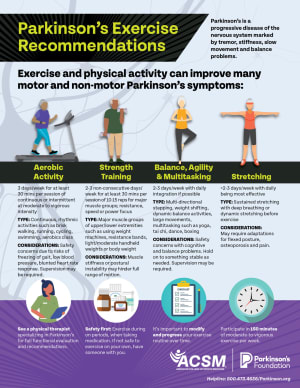
Living with Parkinson’s disease can feel like navigating a new set of challenges every day. Symptoms like tremors, stiffness, slower movement, and balance issues may seem overwhelming. But research continues to show that regular exercise is one of the most powerful tools available—not just for improving physical abilities, but also for boosting mood, mental clarity, and overall quality of life.
Exercise is more than a helpful addition to treatment; it’s a cornerstone of managing Parkinson’s symptoms. Think of it as medicine for both the body and the mind.
Why Exercise Matters
The American College of Sports Medicine recommends that people with Parkinson’s aim for about 150 minutes of moderate-to-vigorous exercise each week. That may sound like a big number at first, but it’s easier to achieve when broken down into a structured routine that includes a mix of cardio, strength, balance, and flexibility training.
Consistent exercise can improve motor symptoms like stiffness, slowness, and tremors, while also supporting non-motor aspects such as mood, sleep, and cognitive function. A well-rounded exercise plan typically includes:
Aerobic activity: 30 minutes at least three times a week
Strength training: 10 to 15 repetitions for major muscle groups, two to three times a week
Balance and agility exercises: two to three days weekly, or ideally every day
Stretching: at least two to three times a week, with daily stretching being even better
This combination addresses the full range of Parkinson’s symptoms, helping people feel stronger, more stable, and more confident in their movements.
Safety Comes First
Because symptoms can vary widely, exercise plans should be personalized. Some tips for exercising safely include:
Schedule workouts for the time of day when medication is most effective.
Be mindful of freezing or sudden changes in balance—use supports or work out with a partner if needed.
Adjust your routine as symptoms fluctuate from day to day.
Seek guidance from a physical therapist or trainer who has experience with Parkinson’s.
The right approach will maximize the benefits of exercise while minimizing the risk of falls or overexertion.
Building Strength and Cardiovascular Endurance
Strength training is especially important for those with Parkinson’s, as it helps combat muscle stiffness and improves posture. Aim for two or three strength sessions each week, using tools like resistance bands, light weights, or your own bodyweight. Even simple exercises, like squats or wall push-ups, can make a noticeable difference in day-to-day activities.
Aerobic exercise is equally critical. Walking, swimming, cycling, or using a treadmill are all excellent options. Sessions can be broken into smaller blocks—two 15-minute walks in a day can be just as effective as one longer session. The goal is to get the heart pumping while staying safe and steady.
Training for Balance and Agility
Parkinson’s often affects balance and coordination, making activities like stepping off a curb or turning quickly more challenging. Balance-focused exercises, such as tai chi, yoga, or dance, help strengthen stabilizing muscles and improve reaction time. Multi-task exercises—like stepping side to side while counting aloud—can also train the brain and body to work together more effectively.
Don’t Skip the Stretching
Flexibility is a key part of maintaining mobility. Gentle stretching helps reduce muscle tightness and can improve posture over time. Incorporating stretches into both warm-ups and cooldowns can make daily movements feel smoother and less restricted.
Could HIIT Be Right for You?
High-Intensity Interval Training (HIIT) is gaining attention for its benefits in Parkinson’s care. This style of exercise involves alternating short bursts of effort—like a fast walk or quick pedal on a stationary bike—with periods of rest or slower movement. Research suggests HIIT may boost brain health, improve dopamine production, and enhance motor control.
However, HIIT should be introduced carefully. It’s not a replacement for steady-state cardio or strength work but can be a powerful complement when guided by a professional and tailored to individual abilities.
Partnering with Professionals
Working with a physical therapist, personal trainer, or exercise specialist who understands Parkinson’s can make all the difference. They can help customize exercises, correct form, and create a plan that adapts to changing needs over time.
A Sample Week
A balanced weekly routine might look like this:
Monday: 30-minute walk and 15 minutes of strength training
Tuesday: Balance exercises and stretching or yoga
Wednesday: Short HIIT session and full-body strength
Thursday: Dance, tai chi, or other agility practice
Friday: Brisk 30-minute walk or bike ride, plus core stability work
Weekend: Active rest with light walking or hobbies
The goal isn’t perfection—it’s consistency.
Final Thoughts
Parkinson’s disease doesn’t have to define someone’s abilities or quality of life. Exercise offers a proven, empowering way to manage symptoms, boost confidence, and maintain independence. With a mix of aerobic exercise, strength training, balance drills, and stretching, anyone living with Parkinson’s can build a routine that supports both physical and emotional health.
The most important step? Just start moving. Even small efforts add up, creating momentum that can transform how life with Parkinson’s feels.



